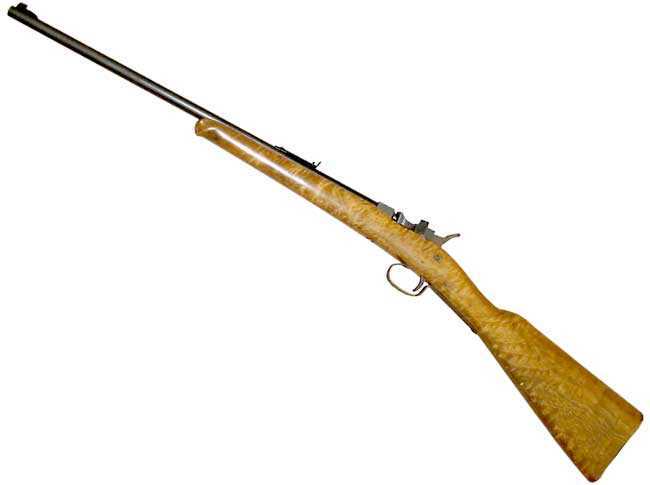
This is the actual rifle I’m testing. I won the lumber lottery with this one!
This report covers:
- The design
- First thing
- Complete the loading
- Save the bullet
- Nowhere to be found
- Sound of the discharge
- Success — sort of
- Use a board!
- Third time is the charm
- Measure the ball
- Summary
Today I hope to test the velocity of the RMAC .22 caliber breechloading black powder rifle. I say I hope because last time I couldn’t get a buckshot out the barrel. I will be doing things to improve my chances today.
The design
Let’s take a moment to look at the design of this rifle. It sure isn’t a redneck-engineered project. Look at the end of the breech that aligns with the barrel.

Look at the exit hole of the breech. Not only is it rounded like the rest of the breech, the edge of the hole is contoured, top and bottom, to fit the rear of the barrel better.
Now look at the rear of the barrel that the rotating breech aligns with. That contoured barrel is not the product of, “Git ‘er done!” technology.
0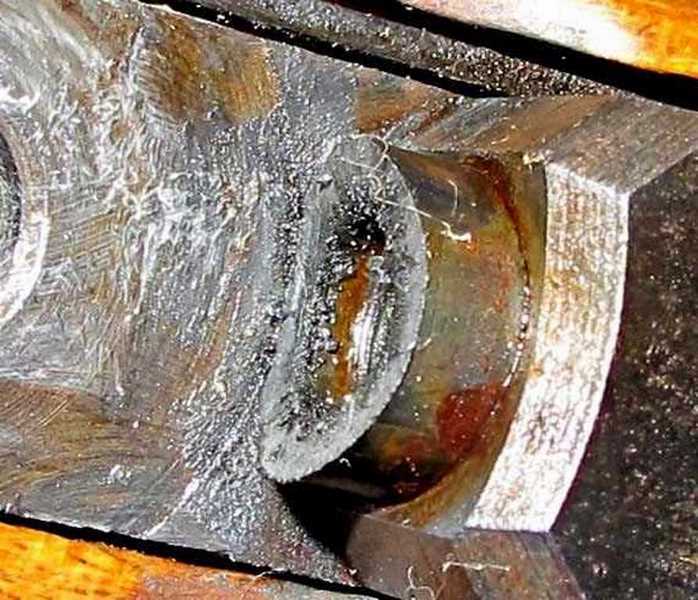
The rear of the barrel is contoured to fit the rotating breech.
First thing
Okay, today’s test is meaningless if I can’t get a bullet to come out of the barrel. So, that is the first thing that has to be done.
Remember that last time I went with a light load of Pyrodex P, a replica black powder that’s equivalent to 3F. Today I will use real 4F black powder. And I will use more of it. Instead of 3.2-3.3 grains, today I’m charging the rifle with — well, I really don’t know. It’s more than 5 grains of powder and less than 6.5 grains, but I’m not loading by weight. I’m loading by volume. I’ll show you.
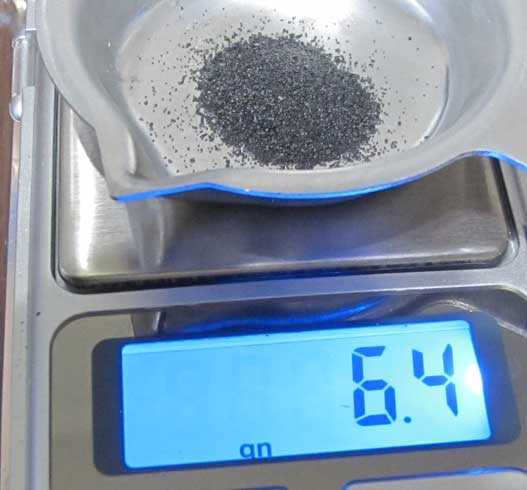
Here is 6.4-grains of 4F black powder.

That is too much powder for this rifle because a ball has to fit on top of it and then be rammed deep enough that the breech can be rotated into position behind the barrel.
There is no mechanical advantage when you use that ball-seating tool. Sure, the powder will compress a little, but only a little. It turns out that filling the powder chamber about three-quarters full is the ticket.

That is about the right level for the powder. It’s almost 6 grains — maybe 5.8 grains? See those grains outside the chamber? Brush them away or they will also burn up when the rifle fires.
Then the ball is placed on top of the powder and three-quarters of the ball will still be outside the chamber. This is where the ramming tool goes to work. Since there is no mechanical advantage, you just press down hard. It’s handy to have a rubber hammer close by.
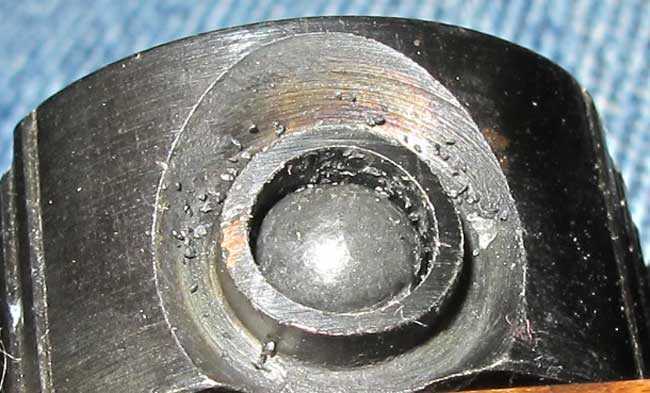
This view doesn’t show it but the top of the ball is about level with the edge of the breech. It should just clear the barrel.
Complete the loading
Now it’s time to punch out a cap, load it into the cap cover, put the cover on the rear of the breech turret and rotate it into position.
Save the bullet
The whole point of this drill was to catch and save the lead buckshot, to be able to measure it when it came out of that .20 caliber barrel. Last time it didn’t make it out of the barrel, so this time with almost twice the powder, plus a finer grade of powder, I expected big things.
I shot into a pug of duct seal, hoping the bullet would remain inside. No such luck! The bullet went all the way through the pug and out the back. Fortunately I backed the pug with my office bullet trap that has two more inches of duct seal, huge chunks of fused pellets everywhere and a steel plate in the back.

The ball from the rifle made a clean hole through the pug of duct seal.

…and went right out the back. That wasn’t expected.
Nowhere to be found
And the ball disappeared in my bullet trap, mixed in with thousands of smashed-up and fused chunks of lead pellets left there from testing. Or maybe the ball was so deformed by hitting those lead chunks that it isn’t recognizable anymore? I couldn’t find it.
Sound of the discharge
Because I was using almost twice the powder this time, I recorded the discharge again. You may recall in Part 3 that it registered at 114.6 decibels. Today the first shot registered 117.5 decibels — the loudest sound I have ever recorded.

The RMAC rifle isn’t quiet! This is the loudest sound I have ever recorded.
Success — sort of
So the first shot was a partial success, because the bullet came out the muzzle. But in every other way it was a failure. I wanted that bullet and I never found it. I reloaded the rifle to go again.
This time it was easier to load the powder because there was no weighing or measuring. Just fill the chamber to the three-quarters mark and you’re done. I actually over-filled it, so I dumped some out and then added just a bit more to get it where I wanted it.
Use a board!
So a thin pug of duct seal didn’t stop the bullet. How about a board? I got a 2-inch by 6-inch plank and put the duct seal behind it. However when I fired, the bullet didn’t go all the way through the board. The board was at least 10 years old and had hardened over time. According to my ELECTRONIC caliper, the base of the bullet is about 0.491 inches into the board, so the whole bullet made it about halfway into the board. This board measures 1.463-inches across. Even though it’s a 2-inch by 6-inch board, that’s the rough measurement, not the finished measurement. And this is a finished board.

The bullet didn’t go all the way through the board. I had to lighten the image a lot to show the hole. Now you know where the term “powder burns” comes from.
Third time is the charm
I’m learning a lot about how this RMAC rifle works. And I will say that every shot has been positive. There have been no failures to ignite. Unlike the Daisy VL that I tested for you, I think this one may turn out to be good!
I realize that it looks like I’m going extra slow, but that’s mostly because I’m learning the gun. Now let’s see if we can catch a bullet!
I reloaded the same as before, but I probably put just a little too much powder into the chamber. That’s not dangerous, but it makes it difficult to ram the ball low enough to be able to rotate the breech. Hence the rubber hammer!
I did have to tap on the wooden end of the ball rammer with the rubber hammer to get the ball low enough to be able to rotate the turret in line with the barrel. And then I shot the third time. Success! The ball went through the pug again, and into a part of my bullet trap where there are no large chunks of lead.
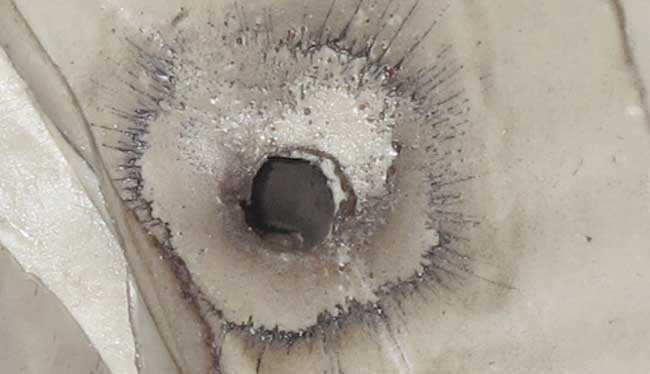
The entry hole in the second pug. Once again you can see the powder burns.
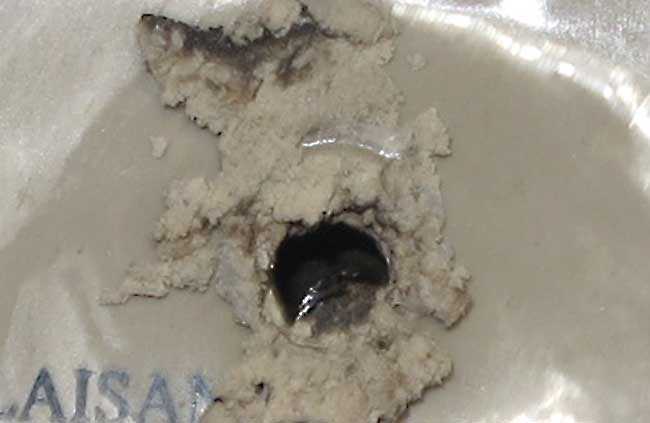
The exit hole from the second pug.

The ball went about a half-inch into the duct seal of the trap without hitting any pellets. It was easy to remove.
Measure the ball
In part 2 I measured a number 4 buckshot ball for you and found the diameter between 0.231 and 0.239-inches. My question, as well as yours, is how does that .20-caliber barrel swage that ball down in size? When I measured the cylindrical part of the recovered ball it was very consistently 0.2195 across, The fat portion measures 0.232 to 0.28 inches. That’s from slowing down so fast in the duct seal.
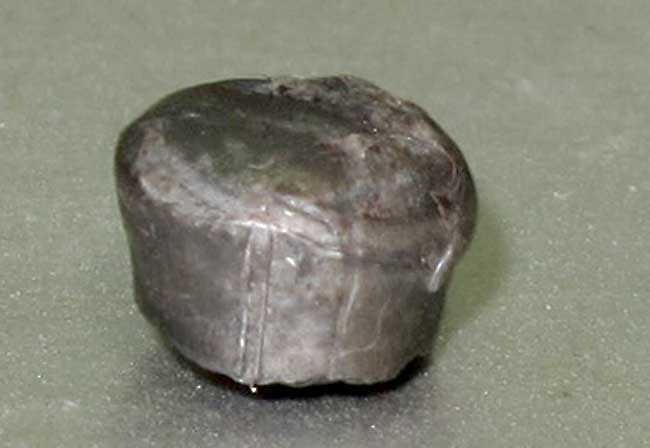
The recovered buckshot ball. The fat end at the top was the front of the ball. Notice the rifling.
Summary
I wanted to test velocity today, but this ball recovery test took longer than anticipated. But I now know how the rifle likes to be loaded and maybe that will give me more consistency when I do test the velocity.


Everyone,
Today it was BB’s fault. I entered the wrong date in the schedule for publishing.
Sorry,
BB
BB,
As long as it was not health related it is not a problem.
Siraniko
It could be related to senility.
I don’t know. Mentally, I’m still wrapping up the month of June. Where did July and two thirds of August go?
It was worth waiting. B.B. please try it with smokeless powder also.
A very good weekend to all
Bill,
I hadn’t thought to do that, but I may.
BB
BB,
Now that is a swage job. If that smacks something, it is going to know it.
BB,
Nothing like a slow methodical progression to safely evaluate this rifle. Kind of reminds me of the thought process in making your Americana rifle which had no known method of firing which you later passed on to one of the readers.
Siraniko
BB,
They may have it published, but it ain’t right. It is a good thing that you are not paying for this. I wish I wasn’t.
BB-
You don’t happen to have a set of the Lee powder dipper scoops, do you? Those could provide consistency from shot to shot.
Paco,
I am using Lee dippers. But filling to 3/4 seems to be the best way. It’s very much like loading a cap and ball revolver cylinder.
BB
BB,
I do not know if you have the room in the barrel breech, but maybe you can shove the ball in the barrel and then fill the chamber. Of course then you would have to pull the entire breech block out to insert the ball. Never mind.
Ooh, ooh, ooh! Maybe a cap and/or a little powder would just push the ball into the breech of the barrel and then you could load up the chamber and fire it with a full load. Typing has my coffee induced mind is running in circles.
BB
You may want to hide behind a tree and tie a string to the trigger when using smokeless powder.
Seriously it was proofed with a hot load of Bullseye and should be fine. That chamber to barrel match up is impressive. Just wondering if there is any way to know if load pressures are approaching the danger zone.
I’m looking forward to many more reports on this one!
Deck
BB, It looks like a gas check on the lower part of the rotating breech, the way its relieved off center, closer to the receiver top. Is that blow by, the dark grey mess? I’m glad it came out. If you had other sizes rotating breeches, then you could put a hotter powder charge in.
Rob
Rob,
I could fill the chamber with black and the gun would still be safe. Couldn’t get a ball in though.
BB
I had an authentic old 1860ish .36 Remington revolver. I wanted to trap a couple of balls as well. I used a telephone book and it worked like a charm. For all you youngsters that’s a book we used to use to look up peoples address and phone numbers! 😉
70gtvert ,
I’ll probably try water at some point.
BB
BB
Glad you got it to fire finally.
And what I don’t see is any rifling on the ball you recovered. It does have a rifled barrel doesn’t it?
Can’t wait to see the velocity and accuracy tests.
I like this gun.
GF1,
There is one rifling groove on the ball I showed in the last pic. I even called your attention to it. It just to the left of the center of the ball.
BB
BB
It doesn’t look like it goes all the way around the swaged ball though.
Are you sure that is rifling. To me it looks like the ball hit something in the trap.
I think shooting into the water will give the best results.
Or maybe even some ballistic gell.
GF1,
Are you teasing me? 🙂
How could the rifling go all the way around the ball?
The ball hit nothing but duct seal. But the soft lead nwas mushroomed when it hit.
BB
BB
The (one) line I see in your picture runs from front of the ball to the back after the barrel swaged it.
Even when I get a pellet from my trap or spinner that has been splatted flat I see rifling in the pellet all around the skirt area.
So to me we should see more marks all the way around the cylinder shape that the ball is now in after being swaged.
B.B.,
This little rifle’s got some snort to her…cool!
Looking forward to velocity and accuracy,
dave
B.B.,
Two questions.
First, how many Lands or Grooves (your choice on which you want to count) does the barrel have? I won’t ask the twist…LOL!
Second, did you notice the “Black or Smokeless Powder” in Part 1 in the picture of the original price tag? It is right above “10. TWO SEPARATE SAFETIES” at the very top edge of the photograph.
My reason for asking is that I can only make out one probable Land Groove made in the swaged ball you recovered photograph. Additionally, I could not find a photograph of the muzzle to determine the number of the barrel’s Lands and Grooves in any of the Parts published thus far.
If you can find time!
Counter steer and STOP all the leaning and looking where you aren’t planning to go! Doofus % √
shootski
shootski,
I’ve been countersteering all day. Scraped the floorboards.
I’ll count the lands, one of which made that groove in the ball.
BB
Hey Tom,
Sounds like the Doofus % √ is improving rapidly…but you have got to STOP riding inside! “Scraped the floorboards” i always had Foot Pegs but I learned today that you are correct “Foot Boards” are actually called motorcycle floorboards on that KOOL Orange Creamsicle!
OBTW: Creamsicle Day was August 14th
https://www.daysoftheyear.com/days/creamsicle-day/
Thanks B.B.,
shootski
Shootski,
That bit of advice, to stop looking where you don’t want to go was a breakthrough concept for me in mountain biking. if you’re going along the edge of the passable route and you’re worried you’ll go off the wrong way, then simply look to where you want to go and you’ll naturally go there. It’s as easy as that. Good call!
Will
Hey Will,
It works for skiing, Driving on Snow or Ice, White Water Kayaking, Surfing, Paragliding, and Snap Shooting too!
shootski
shootski,
So in simple terms, “Watch where you are going!”
Siraniko
Siraniko,
Sounds so easy right!
And yet, seems that for some folks and in some instances it gets really HARD fast. The number of people I have witnessed skiing into trees or lift polls/stanchions blows my mind.
shootski
Gunfun1 and Fish,
This one is for the two of you:
http://www.swivelmachine.com/html/stealthpl.htm
This system came out in the early ’90s and it does what you two were talking about and much, much more. B.B. tried to talk me out of buying this back then because he was TOTALLY into spring pistons back then; can’t blame him since PCPs were a big unknown to most folks at that time. I learned everything I know about the Dark Side making that rifle a shooter. Even got the pneumatic trigger to have a reasonable pull weight! Bottle regulators, HPA, plenums, GAS, bullet (slug)Ballistics and also learned all about LW barrels and accuracy.
So back in the 1990s I already had a multi-shot 150+ foot-pound pcp in .25 caliber. The .38 was much more powerful.
B.B. did a review of the Stealth back a few decades ago but it wasn’t his gun and the owner didn’t have the mods I had incorporated…some of those are on the list i linked to.
I think just that airrifle makes me an ALL AROUND Airgunner!
shootski
Shootski,
Those things were awesome! They came in a nice little break down case. I talked to a salesman on the phone once. He was telling me they sold them to the Israeli army with a 9mm barrel. I thought long and hard about getting one way back when, but they were really expensive back then. Just could not swing it.
RidgeRunner,
The craftsmanship and materials on the metalwork was top notch. It however didn’t have a trigger that most airgunners would tolerate. Without a down regulated pressure from even the 2,000psi HPA bottles the trigger was off the charts. Since it used basically a spool valve it could work once you got it down to 1,600psi and the trigger didn’t need to be slapped if you use
a Plenum with a slide check valve.
Yea most people would never want to put that much work into something that cost over 2K to begin with. By putting on my thinking cap i did learn much of the SECRETS of the Dark Side with the early modern PCP bunch. The problem that Tom talks about the multi-shot revolver magazine being hard to turn was solved by establishing torque values for the fasteners for the revolver frame that made it square within ten thousandths or better. I still shoot my 300 of 300 using 22cu in bottles at 3,000 regulated down to 1300-1600psi. I’m looking for a CF 4,500 regulated bottle(s) that will fit without more mods. I have taken medium to small depredating porkers with the .25 at 75 with one shot.
shootski
Shootski,
I had heard of several of the issues, most especially from Fred Liady as he had one in his collection. Yes, it appeared to be top shelf quality, but issues such as the trigger on something that expensive…
Yes, it was way ahead of it’s time. I would not be surprised to find out one made it’s way up to Scandinavia.
There are some long, slim CF bottles out there that will handle 4500 PSI and regulators to fit them. Now, will they fit your Stealth? Umarex has one on their Hammer. If I am not mistaken they are also on the Urragons. Talk with Joe Brancato. He might be able to fix you up.
http://www.airtanksforsale.com/
I picked up my HM1000X from him.
RidgeRunner,
Thanks for the tip! I have dealt with Joe for years for all my HPA needs; he is Good People! We even have crossed paths in the Philly area that family originate from.
I do need to say i have only thought about the 4,500 CF upgrade and used your Sage advice on; “What is the purpose?” So until i need/get more than eight or nine shots to take out a Singular i don’t need to spend $$$ on the upgrade.
shootski
Shootski
I checked out the link. Pretty cool guns.
Gunfun1,
From decades ago!
Way before the right time.
shootski
Shootski
Kind of thought that. And as usual the price.
Probably wouldn’t of bought one anyway. Just not the interest for me.
BB: I’m hoping that I might encourage you to address Field Target shooting once again. I’ve pulled up and read the American FieldTarget Shooting web page, but would love to hear your words about it. My wife and I (well mostly me) are looking forward to attending (as visitors) the match in San Louis Obispo, CA this October. We have a very nice airgun range in the 55 yr old plus resort where I live, but unfortunately, it sits mostly unused. A good friend and neighbor and I have been the only shooters on our range this entire year. I’m looking forward to encouraging others to come out as it cools down this Fall. Anyway, I look forward to some of your sage advice to help build my knowledge and skills at the sport of Field Target Shooting. As always, I thank you. Orv
Hoppalong Doc,
Maybe you can get a club rolling by first generating interest among others using a Wacky Match described by Edith here: /blog/ then later on building the club along as outlined here: /blog/2008/10/starting-your-own-field-target-club-scoring/ Hopefully BB can refresh the articles with the new and updated developments.
Just a young whippersnapper trying to help out.
Siraniko
SIRANKO: Your input is of great value. What I wrote below to BB is said equally to you. Thank you with huge explosive rounds going off all around. I don’t want to be asking too much, but how do you index the information on these blog entries? I am a bit of a Luddite when it comes to computers, but an explanation targeted for my poorly educated brain would be appreciated. Once again, thank so much for your input, Orv
Hoppalong Doc,
One way to search the blog if google is your browsers default search engine is to search for: site:pyramydair.com/blog “field target”
Or use google advanced search. Go to
https://www.google.com/advanced_search
and fill in the appropriate fields. Happy searching. – Don
Hoppalong Doc,
Well having read most of the entries in the blog since the beginning helps. On the upper right hand corner on a desktop is a box with a magnifying glass to search topics with. If you are on a tablet or cellphone it’s somewhere near the bottom.
Since there are only two of you using the airgun range I’d suggest you guys start off making the activity more fun and attractive to others. Keeping the match fun and simple. Slowly building up challenges as money and facilities allow. If people are going to join what will they be using compared to what you are currently using? Can they compete using something bought at Wally World? They are going to get disappointed if they can’t. I’d use larger than regular targets first then once they are consistently hitting those make it more challenging.
Siraniko
Hoppy,
I can do that. Though my experience in starting a club is now 25 years in the past, it still works.
BB
I feel like such a novice about all of this: picture a 73 year old kid running about the Christmas tree wanting to open all the gifts at once, whether they’re for him or not! Before I attempt starting a Field Target club, I believe I’d best read all the information I can find, and attend a few organized events with my mouth shut and my eyes and ears wide open. I am appreciating your blog entries on “How to start a Field Target Club” These make me want to jump right in and start a club right away, but at this point I’d surely make the rear end of a horse of myself. Of course I ‘ll continue shooting at our neighborhood range as often as possible. Whatever words of wisdom that I can glean from you and the experienced readers of this blog will be greatly valued. Thank you.
Now, my ever eager mind has another query for you: Last year I purchased through Pyramyd a replica Colt 1911 pellot pistol. I’ve been enjoying it as it feels exactly like the one carried as a corpsman all those years ago in Vietnam (don’t let anyone fool you into thinking that corpsmen were all pacifists and went about unarmed. It just wasn’t so, as those of us who desired to stay alive were just as armed as our Marine brothers). I also just recently received a beautiful chrome Baretta 92FS pellet pistol. Both replica guns are manufactured under license by Umarex. I find that both guns seem to be nearly identical mechanically, with only a couple of the “bells and whistles” being different. The appearance of each pistol remains true to their powder burning parent, but, as I noticed above, their shooting mechanics appear the same. I do find that my 1911 is a bit more accurate than it’s Baretta mate, but this may well be due to the fact that the Cole has many more pellets run through it. I guess that my question is, does Umarex simply put a different facade on these guns, or are they truly different mechanically? Lastly, I note that the Baretta is manufactured in Germany, but how about the Colt? Where is it made? I know that I’m probably annoying you like one of those wasps you’ve shredding with your fancy salt shaker of late . . . but you’ve got to wear the yoke for those big bucks. That was rude, sorry. You are in fact greatly appreciated. Orv
Hoppy,
Yes. Under the skin all those pistols are alike. That’s how they make money on them and how they make them work so well.
Where is the Colt pistol made? Well, somewhere on the box or in the manual it should tell you. My box says Taiwan.
BB
As usual BB, you are exactly correct. My Colt 1911 didn’t come in a box, but in a nice Umarex plastic gun case. As I reviewed my owner’s manual it clearly “in fine print” states that my pistol was manufactured in Taiwan, just as you thought. I don’t want to be guilty of “pre-judging”, but I’m rarely as pleased with “mainland ” China’s manufacturing prowess as I am with the rest of the world’s. Well. I promised to wash the dog today, so I’d better hop to it. Thanks, as always. Orv
RidgeRunner,
The scope cover arrived today. Thank you! Very kind. This has to be the first instance of a non-entry winning a prize!
Derrick
Derrick,
I am glad you liked it. The fact that you yielded a chance to win to the others showed me you were most deserving of a prize.
I would like to see others do this. I know we all have lots of airgun doodads that have piled up over the years. What are we going to do with them? Why not share them with other airgunners here? I just gave away a bunch of new and used scope rings, etc. that have been piling up over the years. I was not going to do anything with them. Maybe these guys can use them. If not, maybe they will pass this stuff on to others. There is bound to be someone around here that can use this stuff.
Are you saving this stuff up for an estate sale? The auctioneers will likely toss all of this stuff into a box and some bidder will get it for almost nothing. You sure will not get anything out of it.
Have your own little giveaway here. I did. It was fun. I am going to do it again. I hope the “winners” can use and/or enjoy some of it.
Hi BB an all,
So is it a squeeze bore? That is pretty exotic.
Best regards,
Carel
Carel,
Yes, I guess you could call it a squeeze bore. And howdy yourself.
BB
BB,
So the actual barrel is a .20 at the end? Did they source barrels from Benjamin? How did they do a squeeze bore barrel economically?
Siraniko
See below.
Siraniko,
It is not a true squeeze bore as the Germans made during WW2.
They started with a .20 barrel and at the breech they machined out a tapered swage to squeeze the ball down. You can get away with this with soft lead, but I would not attempt this with modern firearms. Go back to part 1 and there is a rough illustration of what is done.
RidgeRunner,
Yeah I realized that. It’s just that the way BB hinted about the barrel it lead me to believe that it was rifled from breech to the end. Now I’m thinking it’s a .20 caliber rifled barrel that had section near the breech reamed out to .22 smoothbore to initially accept the #4 shot.
Siraniko
I would like to once again take this opportunity to inform everyone here of the upcoming 8th Annual North Carolina Airgun Show on October 15th and 16th. It is being held in a huge venue with four rows of tables almost a football field long. There will also be a food vendor onsite and a shooting range in the back in a huge open field that will allow over one hundred yards of shooting for however many wish to do such.
Be there or be square.
OK! I knew it would only be a matter of time. It looks as though there are some challengers stepping up to take on the high price gang with something a little more affordable.
https://hardairmagazine.com/news/benjamin-gunnar-pcp-air-rifle/
RR
I like it.
Off subject. For indoor defense the Flyshooter, The Original Bug Gun, is a springer and is the cat’s meow for taking down house flies. I’m improving my reverse ballistics hold under technique and batting 1000 on last 3 encounters.
Even my wife of 61 years, who dislikes guns, is laughing.
Deck
Deck,
To help your Kill Ratio remember that when a house fly takes off they can have an initial rearward, sideways or “normal” flight path. Since they see way faster than we do i would guess that they can see that salt coming and go away from it; so speed up that salt!
Maybe I can start a salt shooter VELOCITY WAR! LOL!
shootski